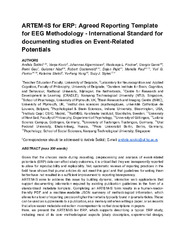Приказ основних података о документу
ARTEM-IS for ERP: Agreed Reporting Template for EEG Methodology -International Standard for documenting studies on Event-Related Potentials
| dc.creator | Stekić, Katarina | |
| dc.creator | Šoškić, Anđela | |
| dc.creator | Vanja, Ković | |
| dc.creator | Algermissen, Johannes | |
| dc.creator | Fischer, Nastassja L. | |
| dc.creator | Ganis, Giorgio | |
| dc.creator | Gau, Remi | |
| dc.creator | Niso, Guiomar | |
| dc.creator | Oostenveld, Robert | |
| dc.creator | Pajić, Dejan | |
| dc.creator | Paul, Mariella | |
| dc.creator | Pavlov, Yuri | |
| dc.creator | Yang, Yu-Fang | |
| dc.creator | Styles, Suzy J | |
| dc.date.accessioned | 2023-05-05T12:36:37Z | |
| dc.date.available | 2023-05-05T12:36:37Z | |
| dc.date.issued | 2023 | |
| dc.identifier.uri | http://reff.f.bg.ac.rs/handle/123456789/4400 | |
| dc.description.abstract | Given that the choices made during recording, preprocessing and analysis of event-related potentials (ERP) data can affect study outcomes, it is critical that they are transparently reported to allow for reproducibility and replicability. Yet, systematic reviews of reporting practices in the field have shown that journal articles do not meet this goal and that guidelines for writing them better have not resulted in a sufficient improvement to reporting transparency.ARTEM-IS aims to address this issue by building dynamic, interactive web applications that support documenting information required by existing publication guidelines in the form of a standardised metadata template. Completing an ARTEM-IS form results in a human-reader-friendly PDF and a machine-readable JSON summary of methodological information, which allows for a level of reporting precision higher than what is typically found in journal articles. These can be used as supplements to a publication, as a memory aid when writing a paper, or as records that allow easier metadata extraction in comparison to verbal descriptions in papers.Here, we present the ARTEM-IS for ERP, which supports describing a typical ERP study, including most of its core methodological aspects (study description, experimental design, hardware, data acquisition, pre-processing, measurement, visualisation, additional comments). We discuss the current contents of the form, web application functionalities, current limitations, and potential directions for future developments. In addition, the process of building the form contents and the web application through a collaborative grassroots initiative is described. Finally, we argue that a wider adoption of ARTEM-IS can bring benefits to different stakeholders: researchers themselves or their collaborators, especially on large-scale projects, reviewers, readers of a paper, and the scientific community at large. | sr |
| dc.language.iso | en | sr |
| dc.publisher | PsyArXiv Preprints | sr |
| dc.rights | openAccess | sr |
| dc.rights.uri | https://creativecommons.org/licenses/by/4.0/ | |
| dc.source | PsyArXiv Preprints | sr |
| dc.subject | Event-related potentials | sr |
| dc.subject | transparency | |
| dc.subject | standardisation | |
| dc.subject | open science | |
| dc.subject | ARTEM-IS | |
| dc.title | ARTEM-IS for ERP: Agreed Reporting Template for EEG Methodology -International Standard for documenting studies on Event-Related Potentials | sr |
| dc.type | article | sr |
| dc.rights.license | BY | sr |
| dc.identifier.doi | 10.31234/osf.io/mq5sy | |
| dc.identifier.fulltext | http://reff.f.bg.ac.rs/bitstream/id/10802/bitstream_10802.pdf | |
| dc.type.version | draft | sr |

